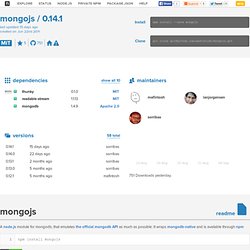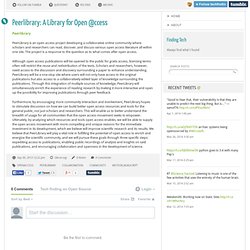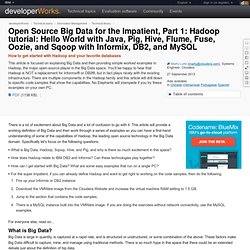

Lovefield: The Data Access Library that Loves You. Shockone/black-screen. Buckets. Are We Fast Yet? Yes We Are! Nodejitsu Inc. Readme A node.js module for mongodb, that emulates the official mongodb API as much as possible.

It wraps mongodb-native and is available through npm Usage mongojs is easy to use: The connection string should follow the format described in the mongo connection string docs. After we connected we can query or update the database just how we would using the mongo API with the exception that we use a callback. If you provide a callback to find or any cursor config operation mongojs will call toArray for you is the same as For more detailed information about the different usages of update and querying see the mongo docs Streaming cursors As of 0.7.0 all cursors are a readable stream of objects. Notice that you should pipe the cursor through a stringifier (like JSONStream) if you want to pipe it to a serial stream like a http response. Tailable cursors. Haunted Docks. Ghost: No Scares to Blog. OnBackend: Seriously Dreamcode. Raw: No Server Fries. Peerlibrary: A Library for Open @ccess.
Peerlibrary PeerLibrary is an open access project developing a collaborative online community where scholars and researchers can read, discover, and discuss various open access literature all within one site.

The project is a response to the question as to what comes after open access. Although open access publications will be opened to the public for gratis access, licensing terms often still restrict the reuse and redistribution of the texts. Scholars and researchers, however, need access to the discussion and discovery surrounding a paper to enhance understanding. PeerLibrary will be a one-stop site where users will not only have access to the original publications but also access to a collaboratively edited layer of knowledge surrounding the publications.
Furthermore, by encouraging more community interaction and involvement, PeerLibrary hopes to stimulate discussion on how we can build better open access resources and tools for the general public, not just scholars and researchers. Togetherjs: Watch me Watch you. BinaryJS: Now Stream 0 and 1. T.co / Twitter. Azer/memdiff · GitHub.
Open Source Big Data for the Impatient, Part 1: Hadoop tutorial: Hello World with Java, Pig, Hive, Flume, Fuse, Oozie, and Sqoop with Informix, DB2, and MySQL. There is a lot of excitement about Big Data and a lot of confusion to go with it.

This article will provide a working definition of Big Data and then work through a series of examples so you can have a first-hand understanding of some of the capabilities of Hadoop, the leading open source technology in the Big Data domain. Specifically let's focus on the following questions. What is Big Data, Hadoop, Sqoop, Hive, and Pig, and why is there so much excitement in this space? How does Hadoop relate to IBM DB2 and Informix? Can these technologies play together? For everyone else, read on... What is Big Data? Big Data is large in quantity, is captured at a rapid rate, and is structured or unstructured, or some combination of the above. Using Big Data technology is not restricted to large volumes. Big Data can be both structured and unstructured. Back to top Why all the excitement? There are many factors contributing to the hype around Big Data, including the following.
What is Hadoop? Figure 1. Classy: Cool Casing for Javascript Classes. AppJS: Bring JavaScript to your Desktop. Great Hackers. Lungo.js - Mobile Framework... and stuff. Java SE 7 has been released. Oracle has released Java 7 today.

This is a big release, but not so much for Java: it’s more about the JVM itself. The biggest change that everyone will love is the addition of InvokeDynamic, which will help dynamic languages built on top of the JVM (like JRuby) immensely. There are some other new features as well, though it’s disappointing to me that JSR335 (also known as ‘zomg lambdas!’) Got pushed back to Java 8. Oh well, that ship sailed long ago, but if you haven’t paid attention to the state of Java in a while, you might have heard that this was going to be in Java 7. You can check out the press release for Java SE 7 on Oracle’s website. NetBeans 7.0 arrives with Java 7 support.
Basic.